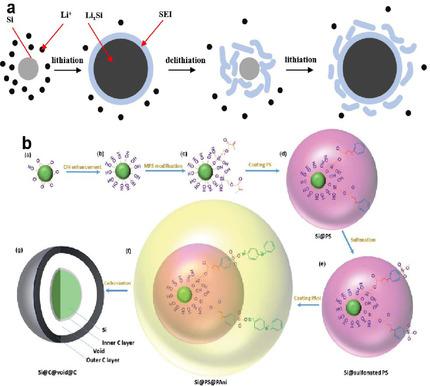当前位置:
X-MOL 学术
›
ChemNanoMat
›
论文详情
Our official English website, www.x-mol.net, welcomes your
feedback! (Note: you will need to create a separate account there.)
Silicon Anodes for High‐Performance Storage Devices: Structural Design, Material Compounding, Advances in Electrolytes and Binders
ChemNanoMat ( IF 2.6 ) Pub Date : 2020-03-12 , DOI: 10.1002/cnma.201900708 Fangru Li 1, 2 , Jie Xu 2 , Zhiwei Hou 1 , Min Li 1 , Ru Yang 1, 2
ChemNanoMat ( IF 2.6 ) Pub Date : 2020-03-12 , DOI: 10.1002/cnma.201900708 Fangru Li 1, 2 , Jie Xu 2 , Zhiwei Hou 1 , Min Li 1 , Ru Yang 1, 2
Affiliation

|
Silicon has an extremely high theoretical capacity, a low voltage platform, and abundant natural reserves. It is considered to be one of the most promising anode materials for lithium‐ion batteries. However, there are still many problems with silicon as an anode material for lithium‐ion batteries. During the lithiation/delithiation of silicon, a huge volume expansion occurs, causing the silicon particles to pulverize and the capacity to drop sharply. Furthermore, the continuous increase in the silicon surface solid electrolyte interphase (SEI) films and the poor conductivity of silicon affect the specific capacity of the battery. Means to improve silicon‐based anodes with regard to electrode cycling performance and electrode capacity include structural design, composite preparation, or improvements in electrolytes and binders (for example, designing silicon nanomaterials of different dimensions from 0D to 3D, including silicon nanoparticles, nanowires, nanorods, thin films, porous silicon, and core‐shell structures). Silicon has been combined with different materials to buffer its own volume expansion, resulting in excellent performance. In addition, the design of a reasonable electrolyte solution, as well as the development of a self‐healing binder is one of the main methods to improve Si‐based anodes. In recent years, sodium/potassium ion batteries have been increasingly studied, and silicon and sodium/potassium can be alloyed. The corresponding theoretical capacity can reach 954 mAh g−1 and 955 mAh g−1, respectively. Advances in silicon‐based anodes for sodium/potassium ion storage are summarized herein.
中文翻译:

高性能存储设备的硅阳极:结构设计,材料复合,电解质和粘合剂的发展
硅具有极高的理论容量,低电压平台和丰富的自然储量。它被认为是锂离子电池最有希望的负极材料之一。但是,硅作为锂离子电池的负极材料仍然存在许多问题。在硅的锂化/去锂化期间,发生巨大的体积膨胀,导致硅颗粒粉碎并且容量急剧下降。此外,硅表面固体电解质中间相(SEI)膜的连续增加和硅的导电性差会影响电池的比容量。在电极循环性能和电极容量方面改善硅基阳极的方法包括结构设计,复合材料制备或电解质和粘合剂的改进(例如,设计尺寸从0D到3D的不同尺寸的硅纳米材料,包括硅纳米颗粒,纳米线,纳米棒,薄膜,多孔硅和核壳结构)。硅已经与不同的材料组合在一起以缓冲其自身的体积膨胀,从而产生了出色的性能。此外,设计合理的电解质溶液以及开发自愈粘合剂是改善硅基阳极的主要方法之一。近年来,钠/钾离子电池已得到越来越多的研究,并且硅和钠/钾可以合金化。相应的理论容量可以达到954 mAh g 硅已经与不同的材料组合在一起以缓冲其自身的体积膨胀,从而产生了出色的性能。此外,设计合理的电解质溶液以及开发自愈粘合剂是改善硅基阳极的主要方法之一。近年来,钠/钾离子电池已得到越来越多的研究,并且硅和钠/钾可以合金化。相应的理论容量可以达到954 mAh g 硅已经与不同的材料组合在一起以缓冲其自身的体积膨胀,从而产生了出色的性能。此外,设计合理的电解质溶液以及开发自愈粘合剂是改善硅基阳极的主要方法之一。近年来,钠/钾离子电池已得到越来越多的研究,并且硅和钠/钾可以合金化。相应的理论容量可以达到954 mAh g 硅和钠/钾可以合金化。相应的理论容量可以达到954 mAh g 硅和钠/钾可以合金化。相应的理论容量可以达到954 mAh g-1和955 mAh g -1。本文总结了用于钠/钾离子存储的硅基阳极的进展。
更新日期:2020-03-12
中文翻译:

高性能存储设备的硅阳极:结构设计,材料复合,电解质和粘合剂的发展
硅具有极高的理论容量,低电压平台和丰富的自然储量。它被认为是锂离子电池最有希望的负极材料之一。但是,硅作为锂离子电池的负极材料仍然存在许多问题。在硅的锂化/去锂化期间,发生巨大的体积膨胀,导致硅颗粒粉碎并且容量急剧下降。此外,硅表面固体电解质中间相(SEI)膜的连续增加和硅的导电性差会影响电池的比容量。在电极循环性能和电极容量方面改善硅基阳极的方法包括结构设计,复合材料制备或电解质和粘合剂的改进(例如,设计尺寸从0D到3D的不同尺寸的硅纳米材料,包括硅纳米颗粒,纳米线,纳米棒,薄膜,多孔硅和核壳结构)。硅已经与不同的材料组合在一起以缓冲其自身的体积膨胀,从而产生了出色的性能。此外,设计合理的电解质溶液以及开发自愈粘合剂是改善硅基阳极的主要方法之一。近年来,钠/钾离子电池已得到越来越多的研究,并且硅和钠/钾可以合金化。相应的理论容量可以达到954 mAh g 硅已经与不同的材料组合在一起以缓冲其自身的体积膨胀,从而产生了出色的性能。此外,设计合理的电解质溶液以及开发自愈粘合剂是改善硅基阳极的主要方法之一。近年来,钠/钾离子电池已得到越来越多的研究,并且硅和钠/钾可以合金化。相应的理论容量可以达到954 mAh g 硅已经与不同的材料组合在一起以缓冲其自身的体积膨胀,从而产生了出色的性能。此外,设计合理的电解质溶液以及开发自愈粘合剂是改善硅基阳极的主要方法之一。近年来,钠/钾离子电池已得到越来越多的研究,并且硅和钠/钾可以合金化。相应的理论容量可以达到954 mAh g 硅和钠/钾可以合金化。相应的理论容量可以达到954 mAh g 硅和钠/钾可以合金化。相应的理论容量可以达到954 mAh g-1和955 mAh g -1。本文总结了用于钠/钾离子存储的硅基阳极的进展。











































 京公网安备 11010802027423号
京公网安备 11010802027423号